Clear wings are one of the distinct traits of butterflies and moths trying to escape predators by using camouflage.
Most butterflies and moths have pigmented wings and this helps for quick species identification.
A smaller group of butterflies and moths have clear wings, on the other hand. These types of species live all over the world and they often spark the interest of researchers.
Table of Contents
Why Are Some Butterfly And Moth Wings Transparent?
Transparent wings on butterflies and moths can be fully or partially clear. Evolution has led these species to develop different levels of wing transparency, mostly to stay safe from predators.
The main reason butterflies and moths have transparent wings is for camouflage and to be less visible to predators.
Since most transparent wing predators live in woodlands or areas of dense vegetation, they become even harder to spot without pigmentation.
Birds are some of the common moth and butterfly predators. They are less likely to see these species whenever they have clear wings.
Clearwing limitations
Transparent wings have considerable limitations as well.
Their wings might help them keep predators away successfully, but they also stand in the way of daily tasks such as maintaining good body temperature.
Poorer thermoregulation capacity
Butterflies and moths use the pigmentation of the wings to warm up. They expose the wings to the sun to get warm.
Transparent wings aren’t as good for thermoregulation for moths and butterflies as some research suggests.
Not as resistant to water
Transparent wings are also not as strong as pigmented wings. Scientists show transparent wings might be even more fragile in habitats with plenty of heavy rain, such as around the tropics.
Still, the benefits of transparent wings in the form of camouflage in front of predators are more important than a poorer ability to self-regulate body head.
Butterflies With Clear Wings
The following species of butterflies and moths are the most likely to be seen around the world.
1. Thick-tipped Greta
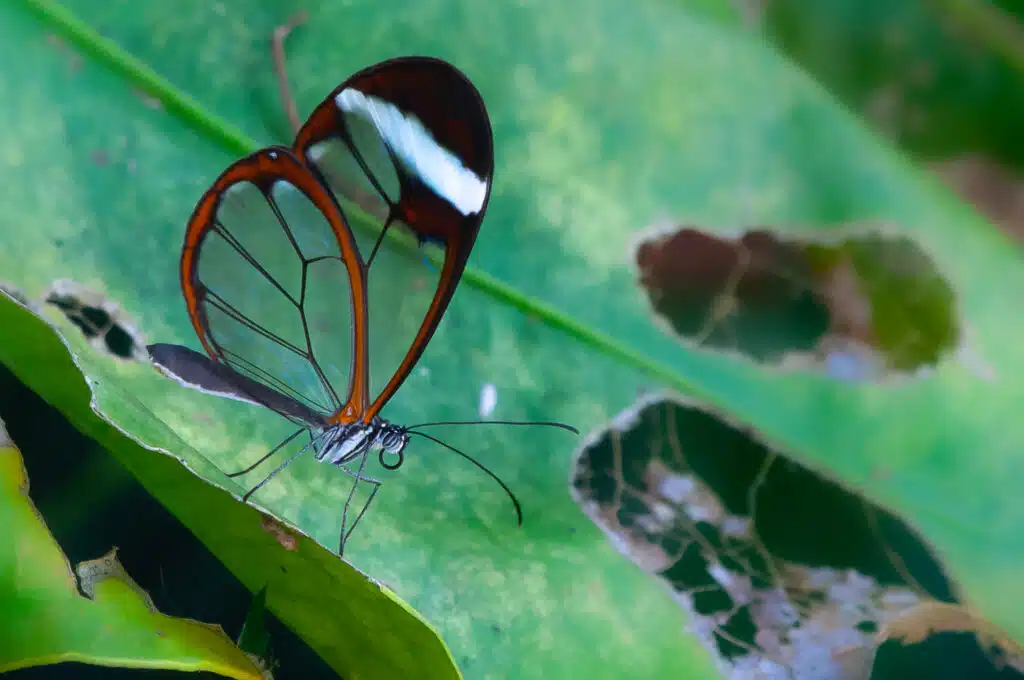
Thick-tipped Greta (Greta morgane) is one of the most common butterflies with transparent wings. This species is highly present around Central America.
Most sections of the wings are transparent. The upper section of the forewings is black with a white stripe. Thin black veins are still visible across the wings.
Thick-tipped Greta butterflies are highly toxic when eaten by predators. Together with transparent wings, this species also takes toxins from plants.
A high amount of toxins is specific to the species. This leads to nausea in predators that eat the butterfly.
2. Andromica Clearwing
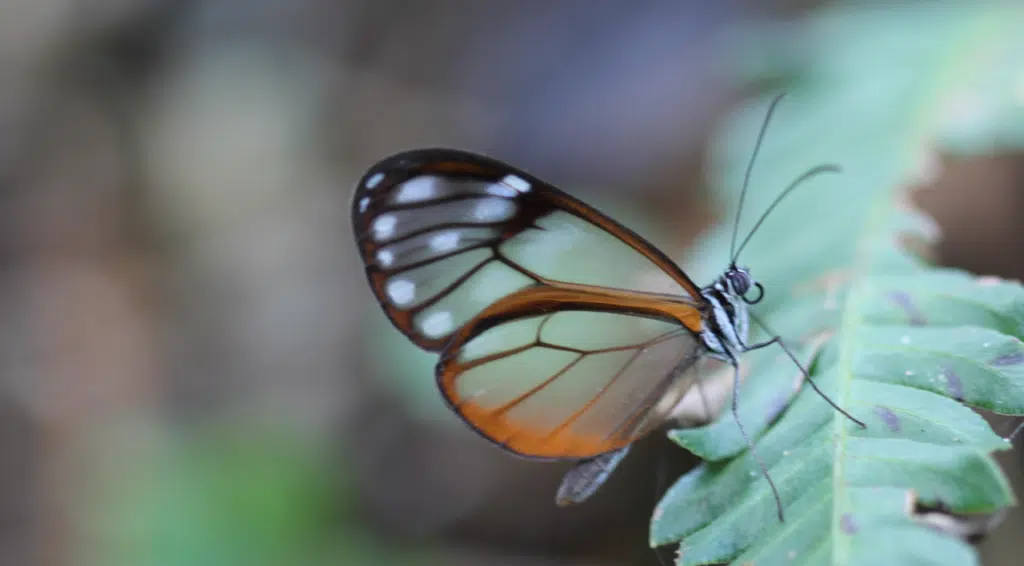
Native to humid tropical climates, Andromica Clearwing butterflies (Greta andromica) have partially transparent wings.
Most areas of the wings are fully transparent while the forewings are partially transparent.
The upper marginal section of the forewings is black with a white band.
Some morphs of the butterfly have white marks across the black sections of the wings instead of a white band.
Wing margins are either orange or brown. This species has a brown body with white ventral color.
Some of the countries where the Andromica Clearwing is found in its highest numbers include Ecuador and Guatemala.
3. White-spotted Clearwing
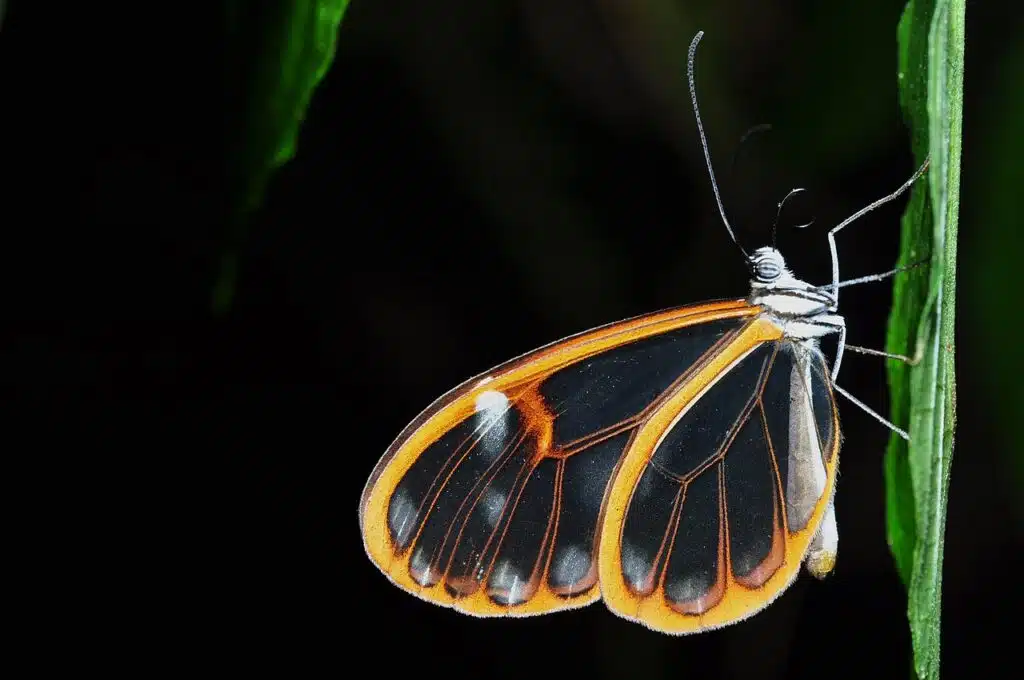
White-spotted Clearwing butterflies (Greta annette) are native to Central America’s tropical climates and forests.
It’s native to multiple countries Such as Mexico and Nicaragua.
This species feeds on jessamines and it has mostly transparent wings.
White-spotted Clearwing butterflies have mostly transparent wings with dark margins and black veins.
The species doesn’t have black coloring on the outer edges of the forewings which remain transparent. However, it has a white band and white spots across the margins of the forewings.
A dark body is also specific to the White-spotted Clearwing. White sections are seen on the ventral side of the body as well as on the head.
4. Glasswing Butterfly
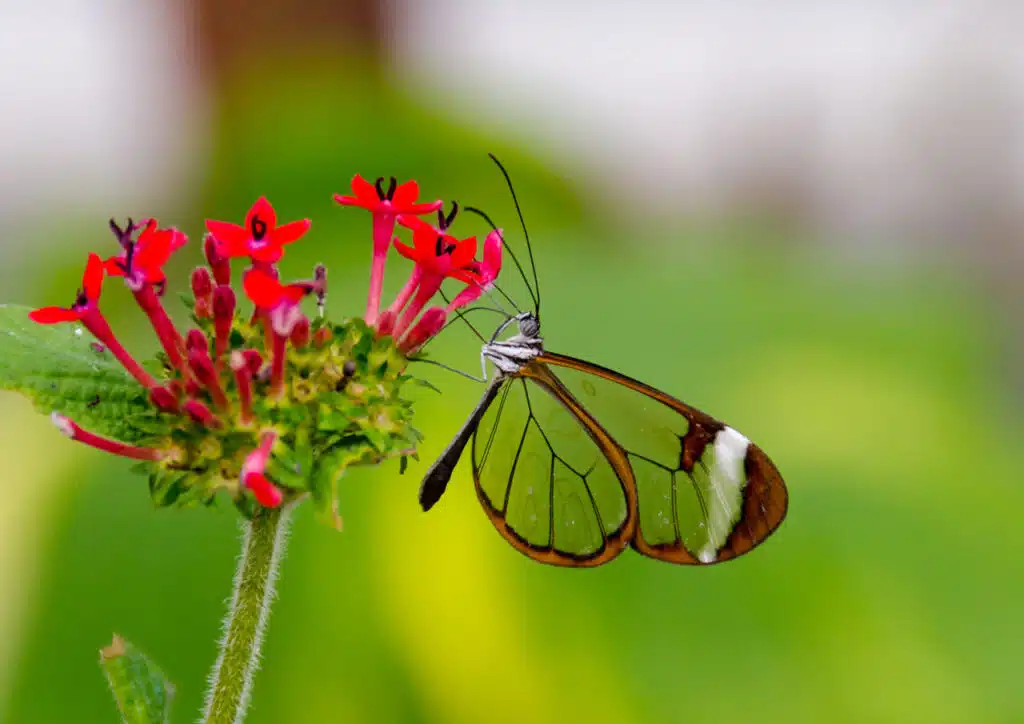
Glasswing Butterflies (Greta oto) are another common species in Central and South America.
This species is also seen in the extreme South of Texas.
Glasswing Butterflies get their name from their transparent wings. This species has black sections with white marks across the margins of the wings.
Glasswing Butterflies are among the few species that migrate. Short migrations are specific to the species, mainly for food.
Adults feed on plant nectar with a wide preference for lantana. Glasswing caterpillars feed on poisonous plants of the Cestrum family. They absorb the toxins of the plant so they have a bad taste for predators.
This species is also known for complex mating strategies.
Males have multiple female partners per lifespan and they gather together in rainforest openings where females can choose the males to mate with.
5. Big Greasy
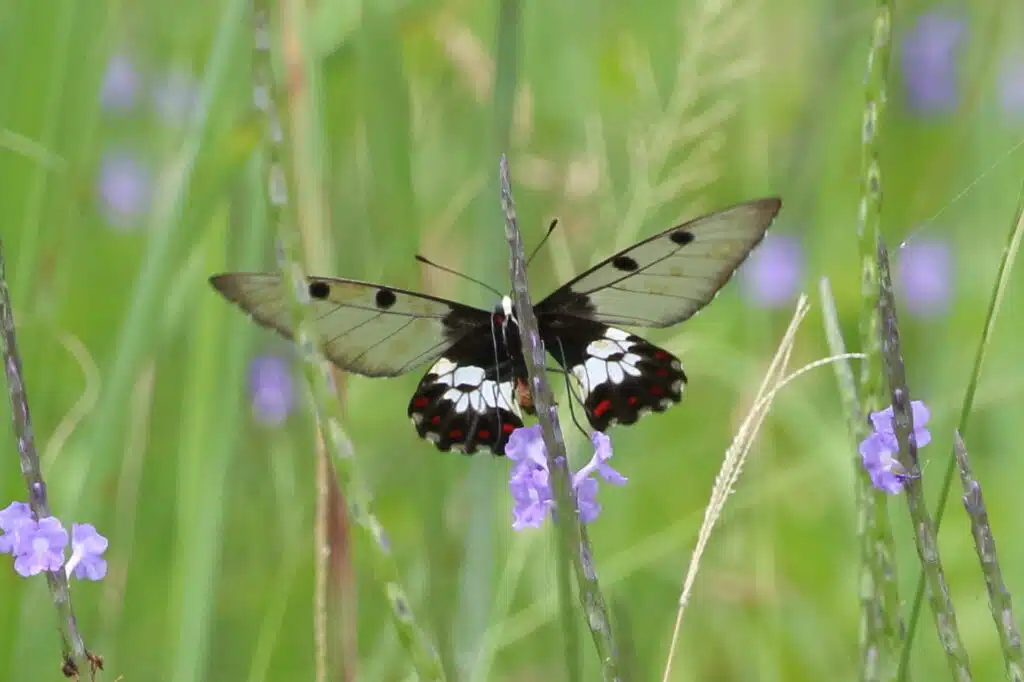
Big Greasy butterflies (Cressida cressida) are native to Australia. This species has partially transparent wings.
Its forewings are transparent while its hindwings have a black base color with fewer transparent sections.
Its body is black, as are the margins of its wings.
Big Greasy butterflies are also some of the largest transparent butterflies in the world. They can have a wingspan of up to 80mm.
Big Greasy butterflies are also among the rare species where the male is larger than the female.
A 10mm difference is common between males and females.
The mating habits of the species are properly documented. Larger males typically seek out females to mate with in-air.
Smaller Big Greasy males mate with females on the ground.
6. Dero Clearwing
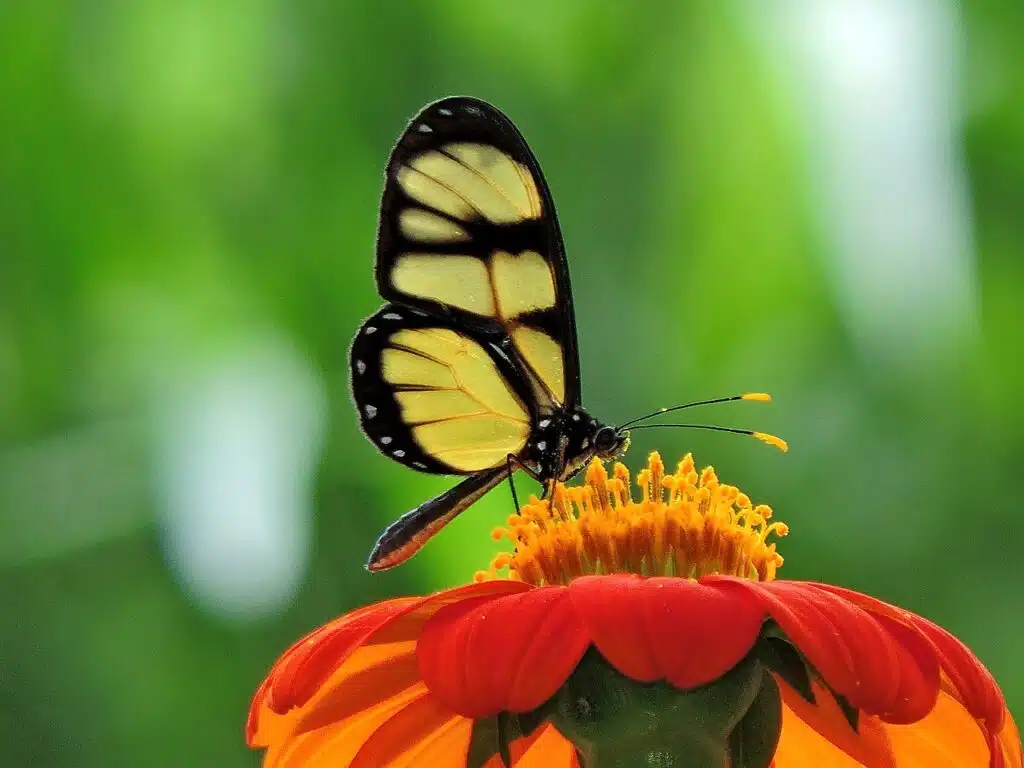
Dero Clearwing butterflies (Dircenna dero) are partially transparent. This species is mostly known for its combination of orange wing sections and transparent wings.
Small differences between the sexes exist within the species.
Males have a wider transparent area of the wings. The forewings and the hindwings are mostly transparent.
An Orange to brown central band is seen across the wings.
Brown is only seen on the margins of the wings and as the main color of the veins.
Females have wider orange color sections of the wings. Their hindwings are mostly orange.
The forewings of the females are mostly transparent with an orange lower section. Wide brown margins are seen on the female.
Small white spots are seen across the margins.
7. Confusa Tigerwing
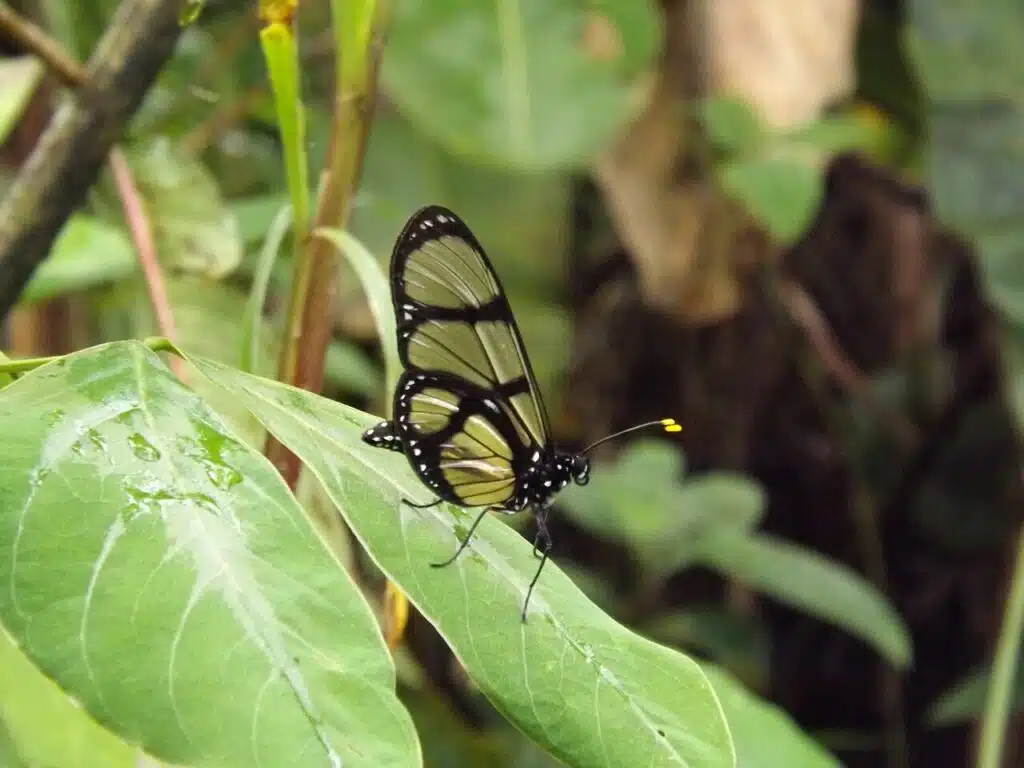
Confusa Tigerwing (Methona confusa) is a transparent and reflective butterfly.
Known for their large size, these butterflies have mostly transparent wings with either brown or black veins and margins according to gender.
You can find these butterflies at high elevations of up to a few thousand feet across South America. Venezuela is one of the countries where the Confusa Tigerwing is found in high numbers.
These types of butterflies inhabit forests and dense vegetation areas at high elevations.
They begin life as caterpillars that feed on nightshade poisonous flowers until they turn into adults.
This allows the species to ingest and store the poisons in the flowers to become detrimental to all predators who eat them.
8. Epityches eupompe
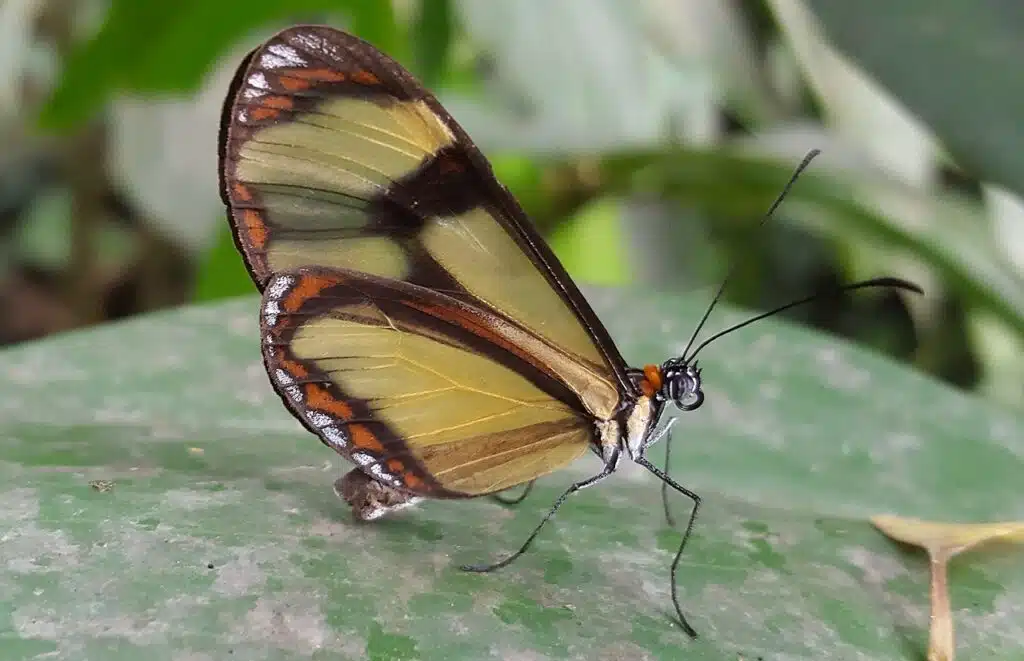
Part of the clearwing genus, this butterfly species stands out with its transparent wings that feature a yellow tint.
The wings of the males are more transparent while the wings of the female have a pronounced yellow tint.
Males have transparent forewings with black margins and brown ting lower forewings. lower forewings.
Their hindwings have a slight yellow tint compared to the forewings.
Females have a more pronounced yellow tint both across the forewings and the hindwings than males.
Dark brown and black margins are specific to the wings of the females. The body has a golden-brown color in females.
9. Patilla Clearwing
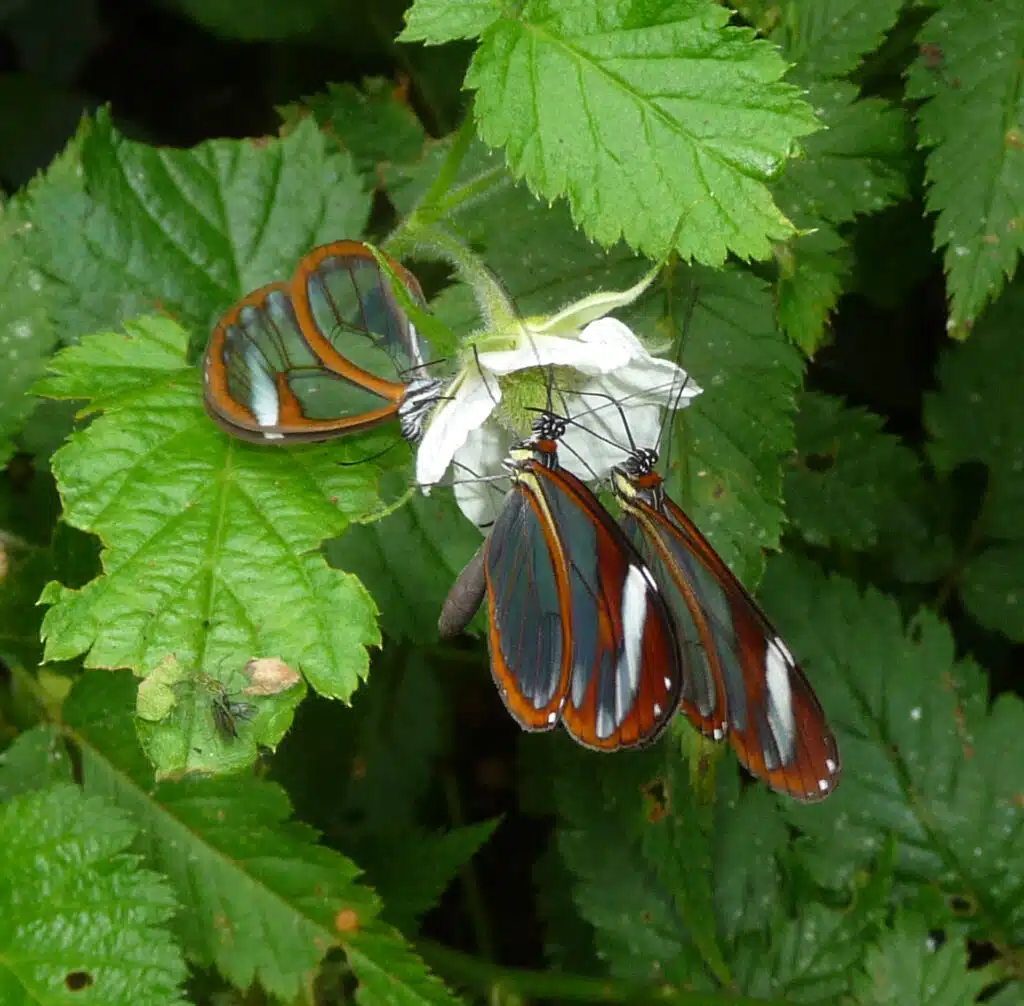
Common across Central America’s tropical forests, Patilla Clearwing (Ithomia patilla) is a typical butterfly with transparent wings.
Its natural habitat is restricted compared to other species with Honduras and Nicaragua being among the few states where the Patilla Clearwing is still seen today.
Red and black colors are specific to the wing margins of the species.
The forewings show black and white coloring with only partial transparency.
Red to brown coloring is also specific to the body of the butterfly.
10. Agnosia Glasswing
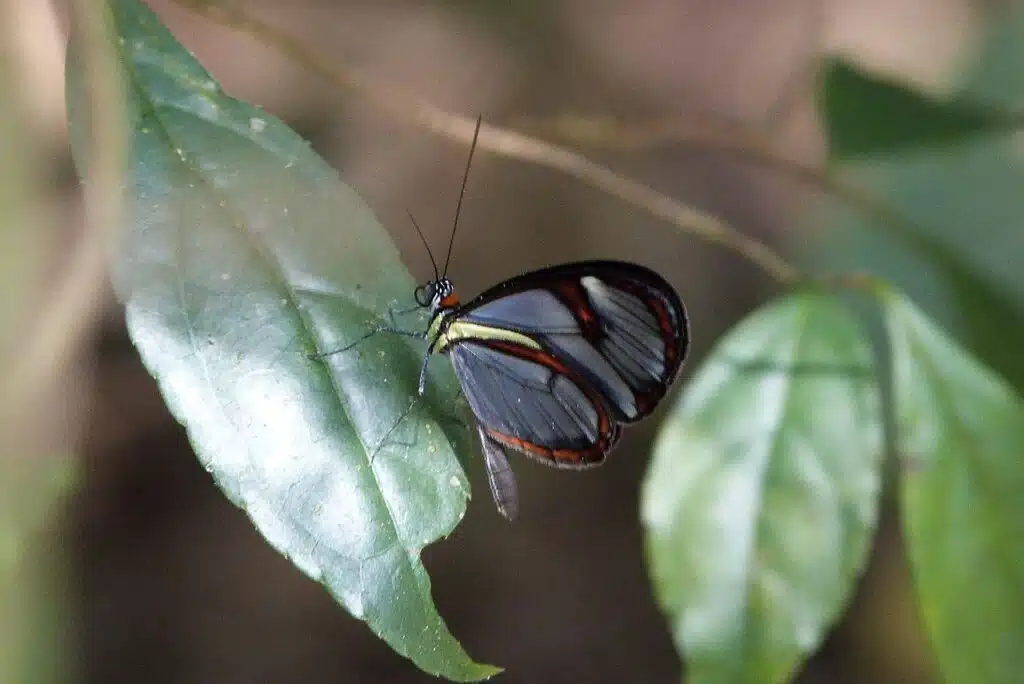
Agnosia Glasswing butterflies (Ithomia agnosia) are common in tropical forests. These butterflies have a very similar appearance to many others with transparent wings.
One of the few methods to tell the difference between Agnosia Glasswing butterflies and other transparent butterflies is by the yellow margins on the ventral side of the forewings.
Otherwise, they have similar transparent wings with black and white forewings just as most other tropical butterflies with transparent wings.
This species of butterfly is diurnal but it’s often only seen in the morning before other insects start to move for food.
No-see-ums are among the most common Agnosia Glasswing predators that the butterflies try to avoid.
11. Episcada hymenaea
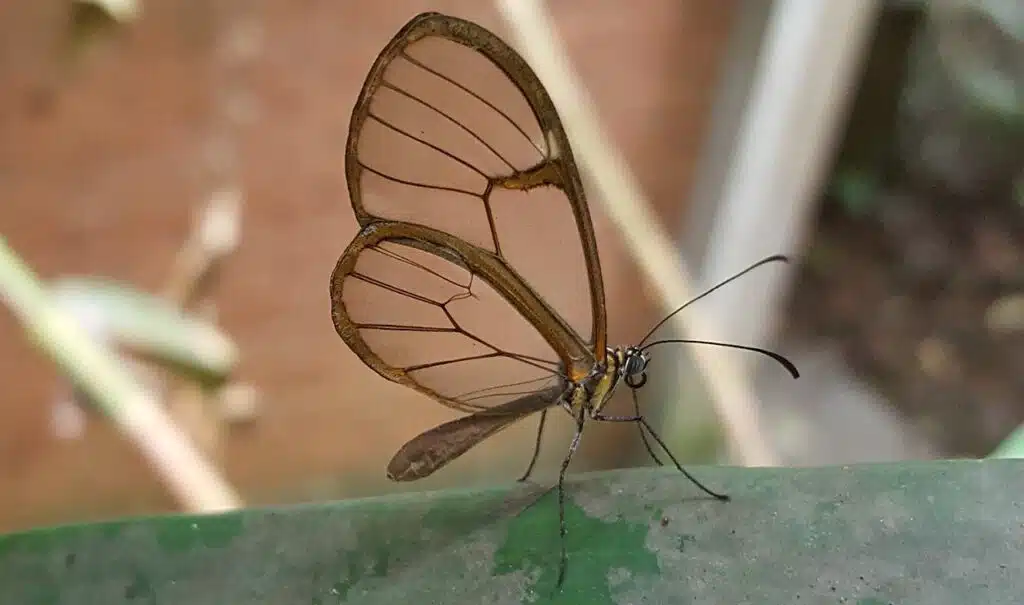
Native to Central and South America, this species of butterfly has an elongated black body with clear forewings and hindwings.
The species has transparent forewings and hindwings.
Unlike other similar species, the butterfly only has one small white spot on each forewing with a reduced black section.
Its hindwings are fully transparent with a small white margin upper side.
Brown margins and brown veins are seen across the wings.
12. Paula’s Clearwing
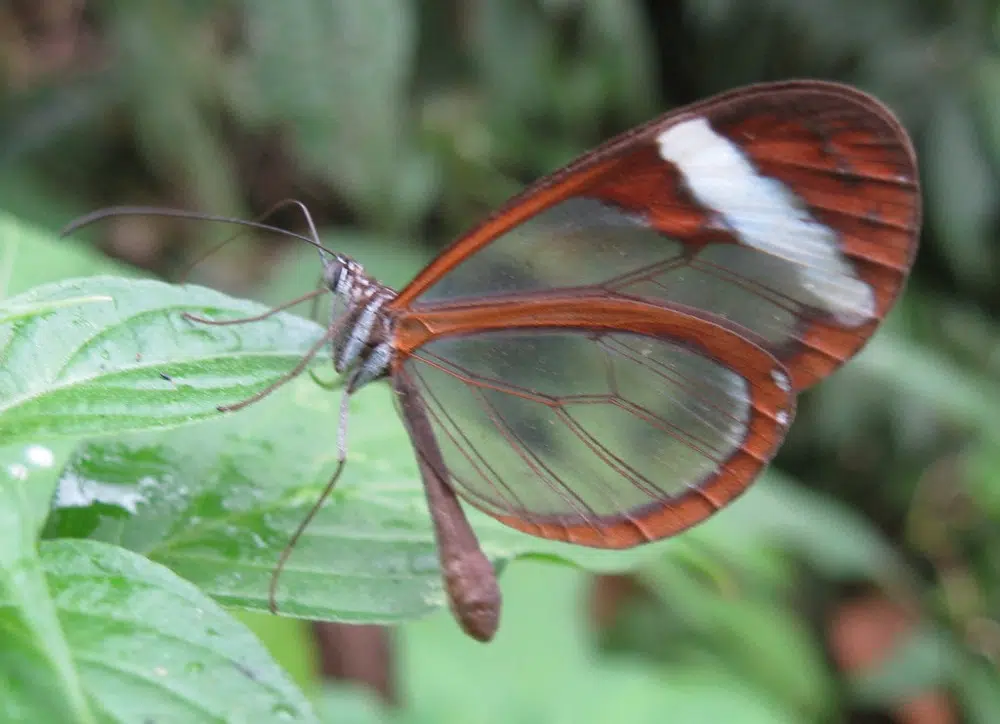
Paula’s Clearwing (Oleria paula) is a small butterfly species native to Costa Rica.
The transparent wings of this species have a blue tint as opposed to the transparent wings of other similar butterflies.
Wide orange margins are seen on the wings of the species with large brown upper wing sections that feature a white band with black borders.
Only the black veins remain visible across the central section of the wings.
The body of the butterfly has white and black coloring with black legs and black antennae.
Moths With Clear Wings
Moths with clearwings are found in high numbers across North and Central America.
1. Hummingbird Clearwing
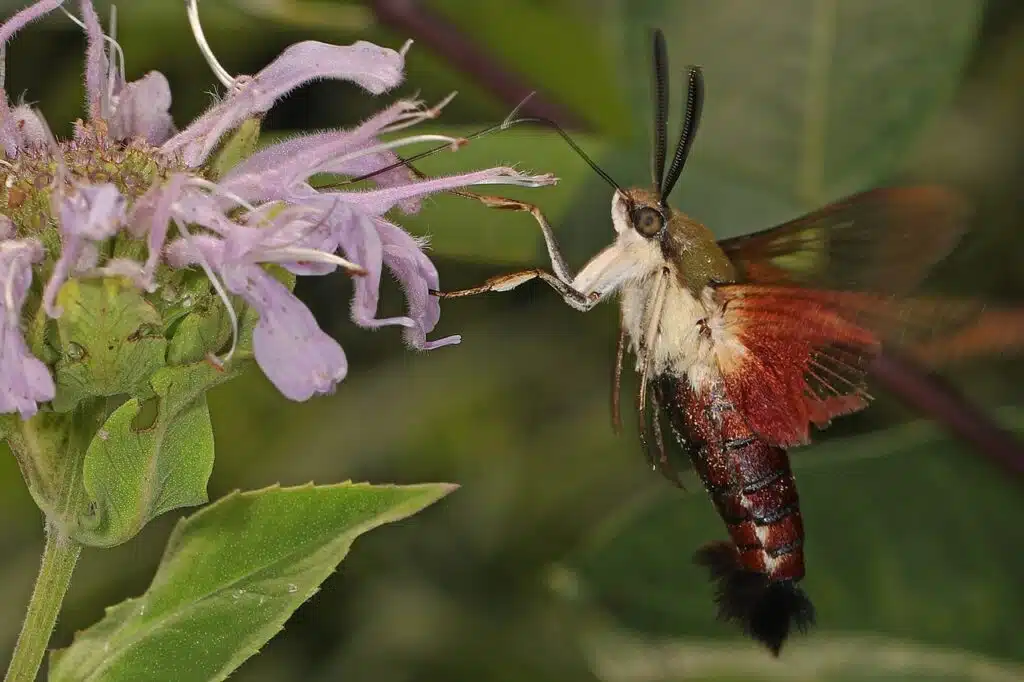
The widespread distribution of the Hummingbird Clearwing (Hemaris thysbe) makes it one of the most common species in North America.
These types of moths are mostly seen across the Eastern US states but their habitat expands North to Alaska.
The species has clear transparent wings with wide red borders.
As its name implies, this species of moth mimics hummingbirds. Both physical characteristics and the way the moth flies remind us of hummingbirds.
With a wingspan of up to 2 inches, the moth is known for having a wide dual-color body. Brown-mustard upper body coloring is completed with red lower body coloring.
These moths also have a white mid-body band.
2. Snowberry Clearwing
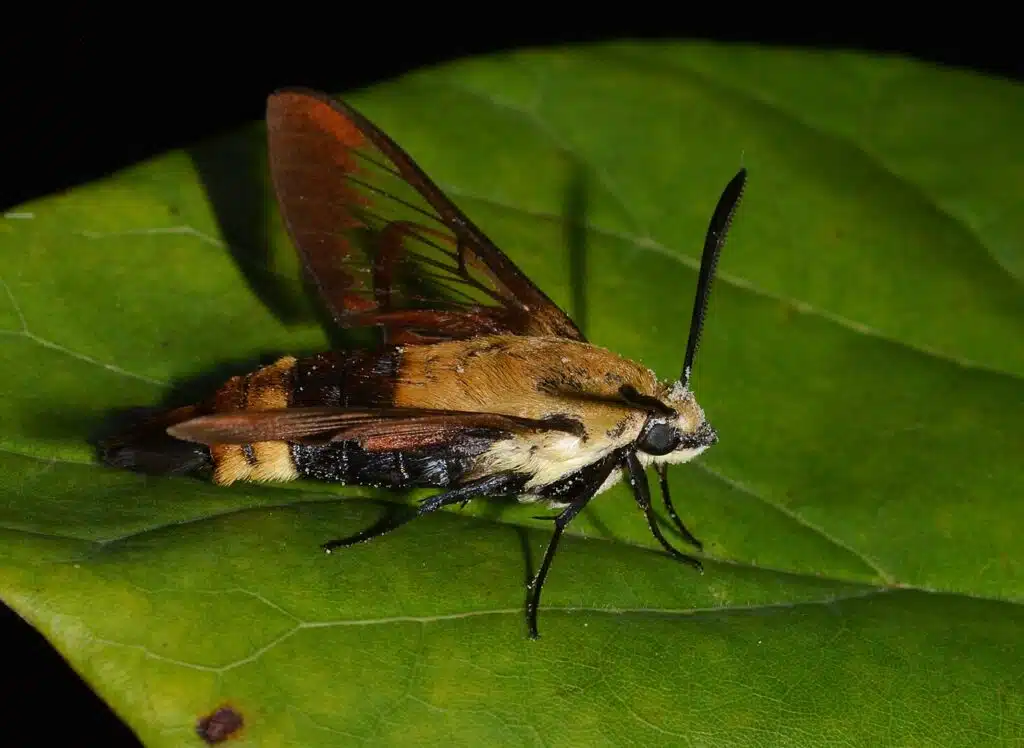
This hairy species (Hemaris diffinis) of moth is native to North America. Its habitat includes open dry areas at different altitudes.
Snowberry Clearwings bear the name of their plant hosts, snowberries. Other hosts of the species include honeysuckles.
These caterpillar hosts also provide the nectar adults consume together with lantana.
You can identify Snowberry Clearwing moths by their transparent wings with visible black veins and wide black margins.
These moths have a yellow to brown hair upper body and a black hairy lower body.
Coloring differs on Snowberry Clearwings compared to the color of the adult Snowberry Clearwing.
The green base color with black dots is specific to the caterpillars of the species.
3. Broad-bordered Bee Hawkmoth
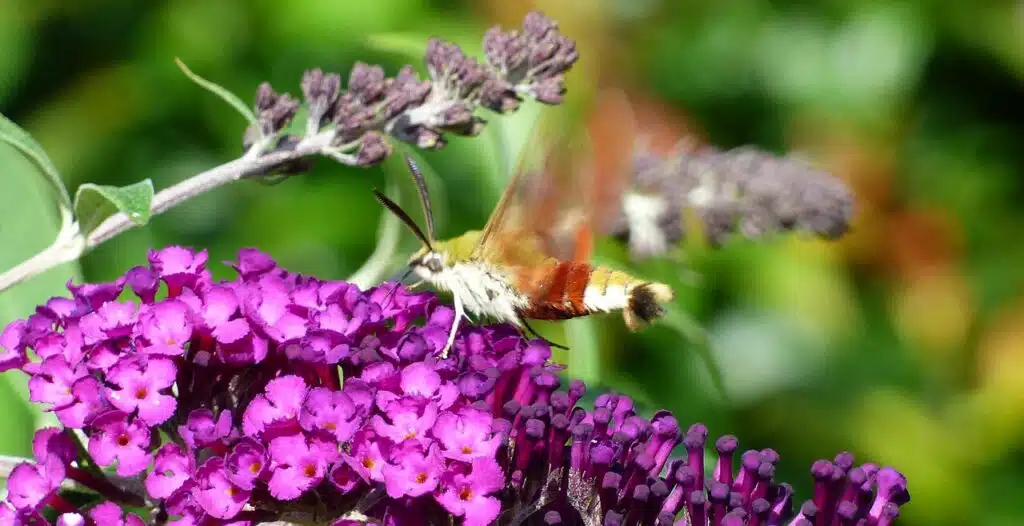
Broad-bordered Bee Hawkmoths (Hemaris fuciformis) resemble bees in yellow and dark brown or black coloring.
This species has a wingspan of up to 48mm and clear wings that make it stand out.
Its clear wings have red to purple borders and visible veins of the same color.
Some morphs of this species have a bright red band across their mid-section as well as across the wings.
Woodlands are among the favorite habitats of the Broad-bordered Bee Hawkmoth.
This species prefers wild snowberry as a nectar source. At the same time, Broad-bordered Bee Hawkmoths might also consider cultivated honeysuckle which can make it a pest in case of an outbreak.
4. Rocky Mountain Clearwing
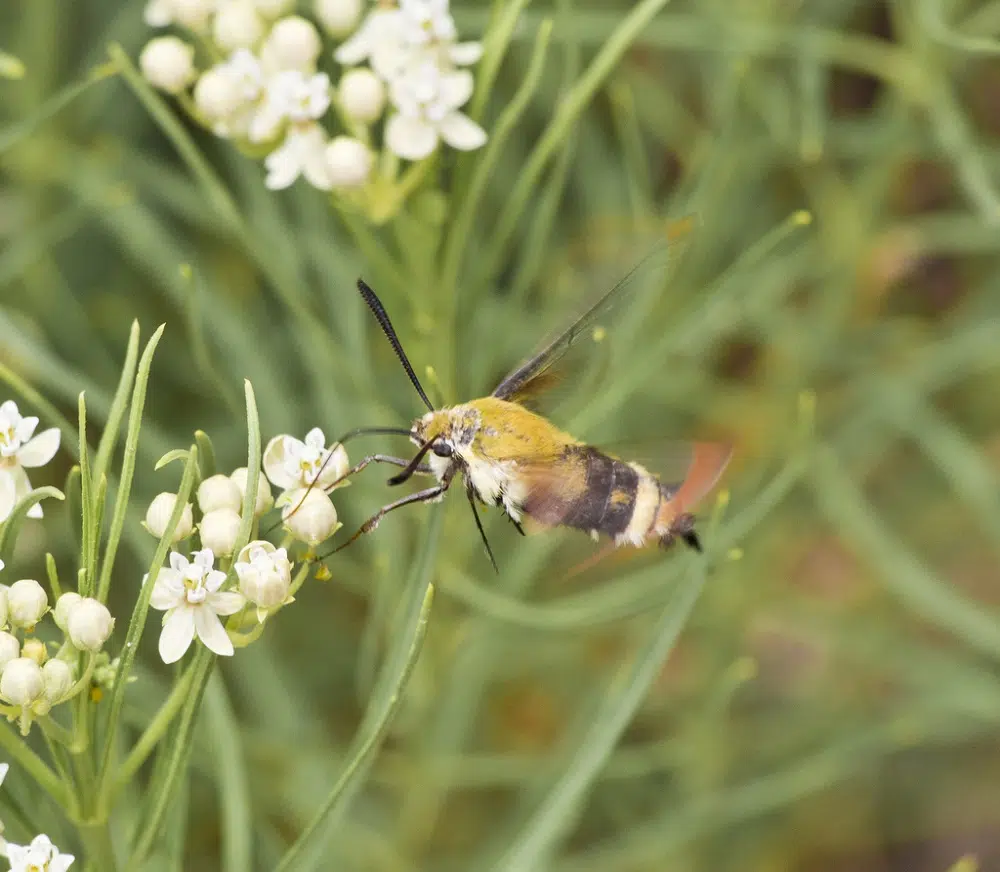
Rocky Mountain Clearwing moths (Hemaris thetis) get their name from the area of North America they inhabit.
This species is commonly found West of The Rocky Mountains and in California where it’s known as the California Clearwing.
The extended range of the species includes Southern states such as New Mexico.
The Rocky Mountain Clearwing moth has a widespread presence in Western Canada as well. This species is also occasionally seen in Mexico,
Moths of this genus have a medium to large size with a wingspan that can reach 50mm.
Rocky Mountain Clearwing moths come in a base yellow-mustard color in a combination with red or black.
Its wings are mostly transparent with either red or black veins and margins.
Lantana is one of the most frequented plants by the nectar-eating adult Rocky Mountain Clearwing.
5. Diervilla Clearwing
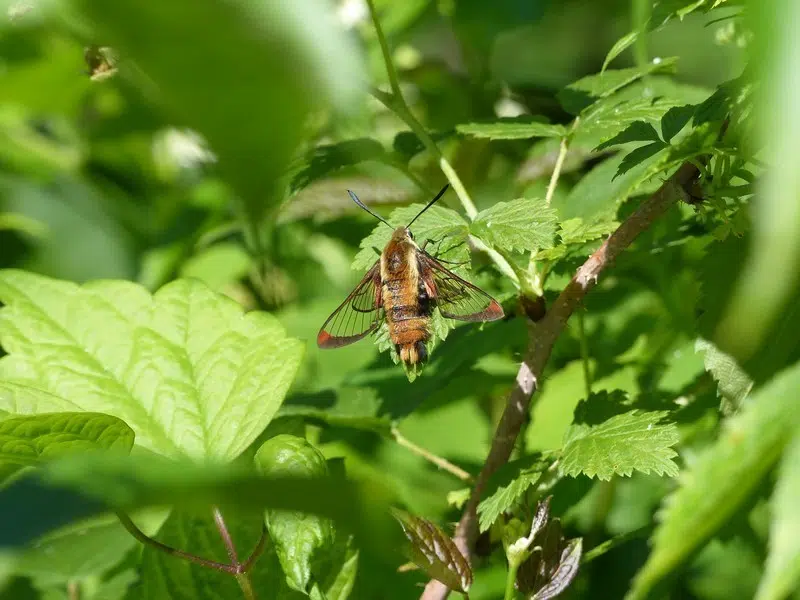
Native to Northern US territories, the Diervilla Clearwing moth (Hemaris aethra) is one of the species with a widespread North American presence.
This species is highly common across all states on the Canada border but they aren’t as numerous as moths in other Southern states.
Diervilla Clearwing moths have a medium to large size with a wingspan of up to 48mm.
You can identify this species by its transparent wings with red-brown veins and margins.
The body of the species is mostly yellow with green to brown central coloring. A black or red band across the mid-section of the body is also characteristic of this species.
One of the distinct traits of this species apart from its transparent wings comes from the fluorescent nature of its caterpillar.
The Diervilla Clearwing caterpillar has a vivid green body color.
Its body shows tiny red dots with yellow borders and a longitudinal yellow stripe across the dorsal side.
6. Narrow-bordered Bee Hawkmoth
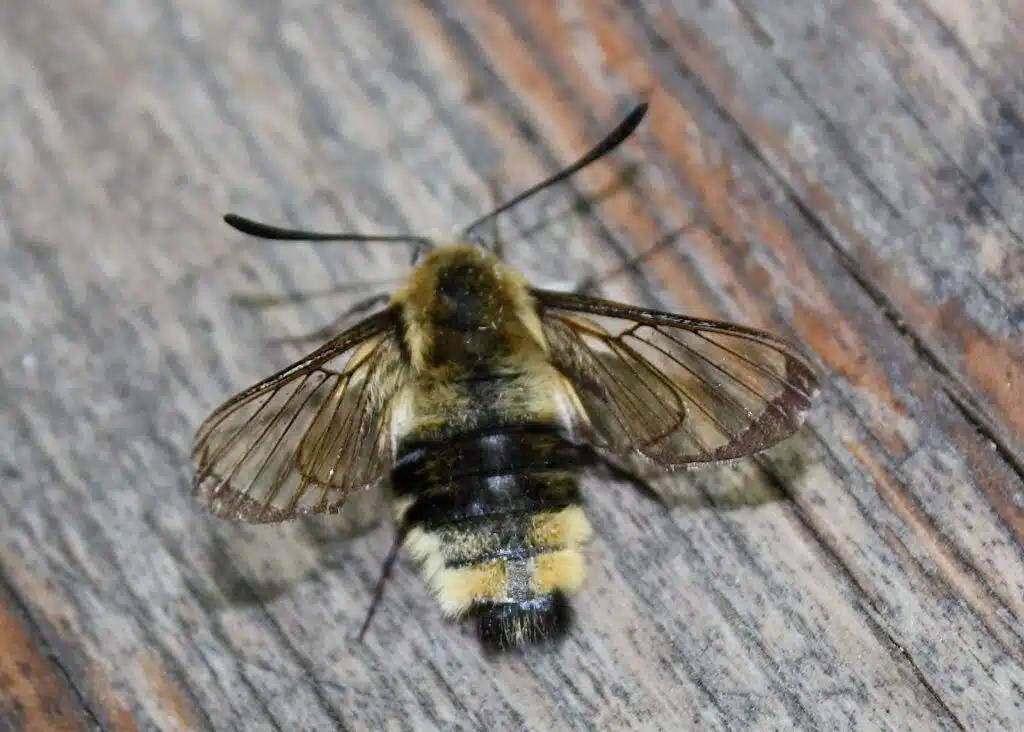
Narrow-bordered Bee Hawkmoths (Hemaris tityus) are common across damp areas and swamps.
These moths have a wingspan of up to 48mm and specific coloring to moths with transparent wings.
Its body has a dark yellow upper section with a white slower section that shows orange central coloring.
A black band separates the 2 colorful areas of the body.
The black band across the body of the Narrow-bordered Bee Hawkmoth tends to fade over time as the moth gets older.
You can find the Narrow Bordered Bee Hawkmoth around various thistles on meadows or in areas with thick short vegetation.
Only one brood is seen every year.
Narrow-bordered Bee Hawkmoths have one of the shortest flight seasons in the world of moths.
They are only active from May to June.
7. Slender Clearwing
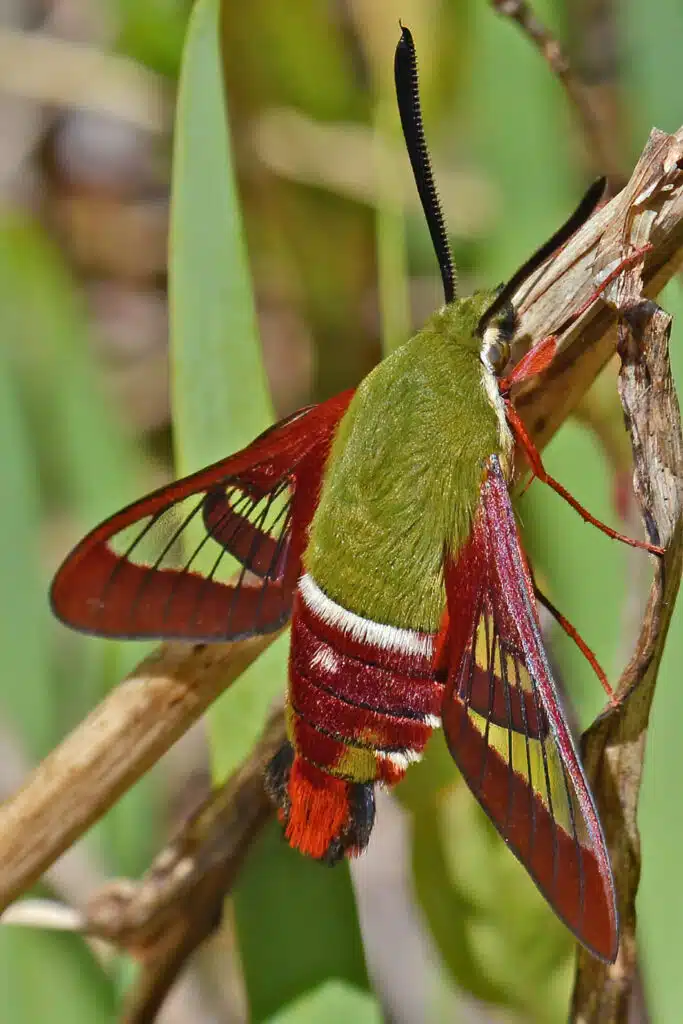
Slender Clearwing moths (Hemaris gracilis) have a widespread North America distribution, particularly in the Southeastern stats.
This species is easier to identify than other moths as it has multiple red bands across its lower body.
The same color is seen on its transparent wings on the veins and the margins of the wings.
Its upper body has a yellow to olive color.
Slender Clearwing moths have a medium to large size. Their wingspan ranges from 40 to 48mm.
Slender Clearwing moths have an established population in many used states but they are also considered endangered in other states.
The season of this moth is considerably longer than the season of other species in the North.
The moth flies from early spring to August.
Short vegetation habitats are the most common place to find the moth. Adults of the species seek out pickerelweed in these habitats to feed on.
8. Hübner’s Wasp Moth
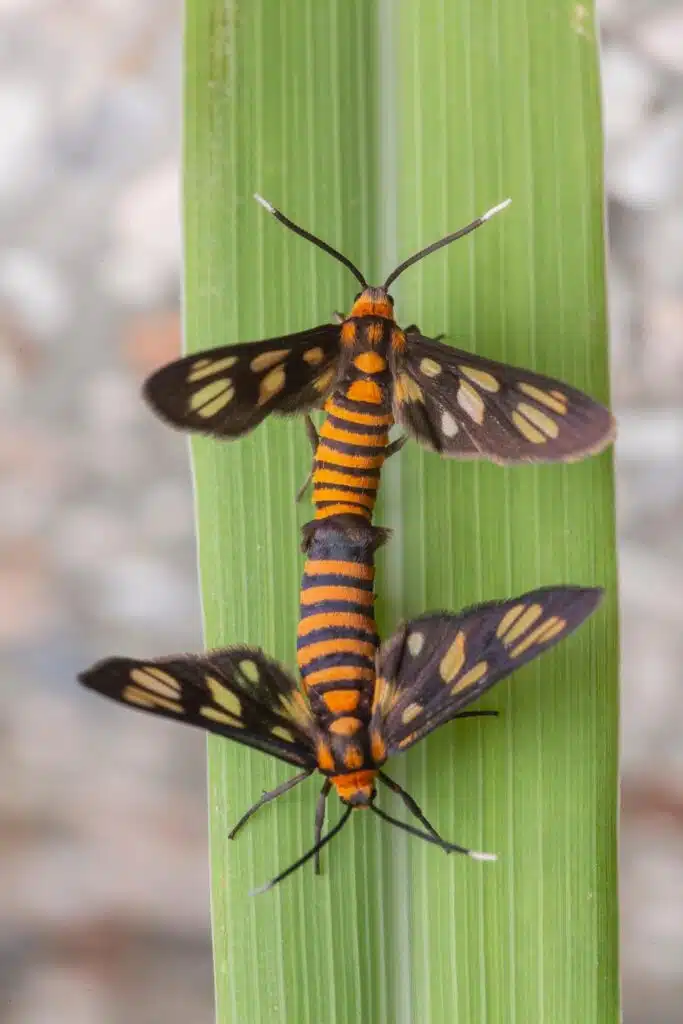
This species of moth (Amata huebneri) has an atypical look. It mimics wasps and this can be seen in its body shape and colors.
Yellow and black or orange and black bands across its body are the main characteristics the moth uses to resemble wasps.
Native to Australia, this species has partially transparent wings.
The wings of the species are mostly black with a few clear spots. The legs and antennae of the species are mostly black.
Some tropical morphs of this moth come in yellow and black colors but all of its morphs feature clear wings.
9. Six-belted Clearwing
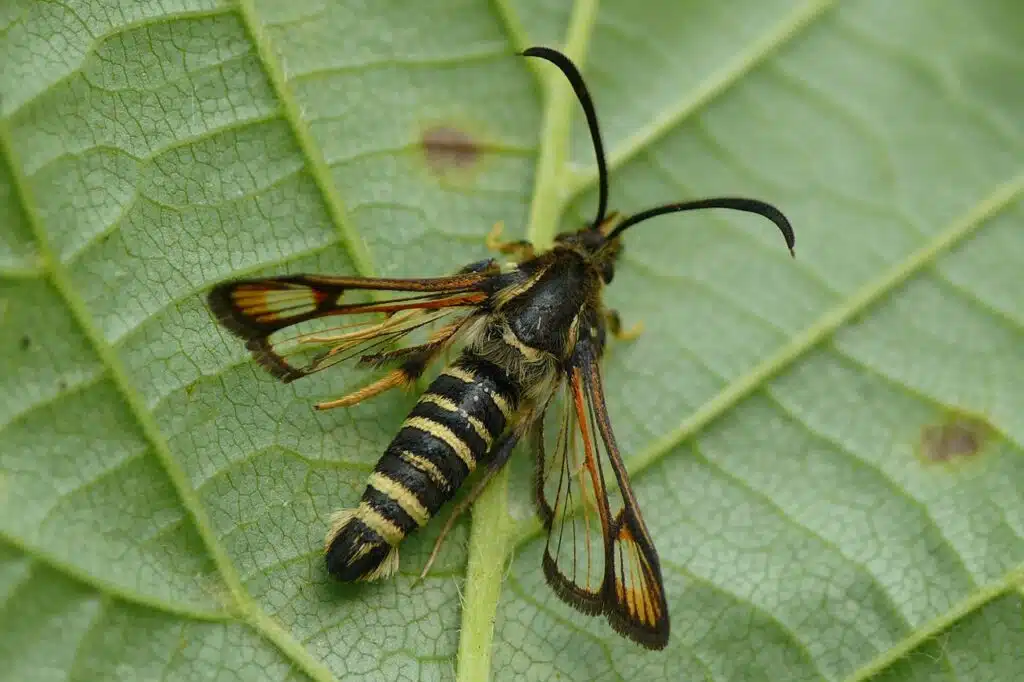
Six-belted Clearwing moths (Bembecia ichneumoniformis) get their names from the number of black and yellow bands across its body.
This species mimics wasps and it has a slender elongated body, atypical to moths. It also mimics wasps in coloring as most of its body is covered in black and yellow sections.
The wings of this mimicking moth are transparent with black and partially yellow borders.
Six-belted Clearwing moths also mimic wasps in size as they rarely measure more than 20mm in wingspan.
Highly common across England, the Six-belted Clearwing is a species associated with coastal areas. The chalk coastal areas are where the moth is most common.
10. Virginia Creeper Clearwing
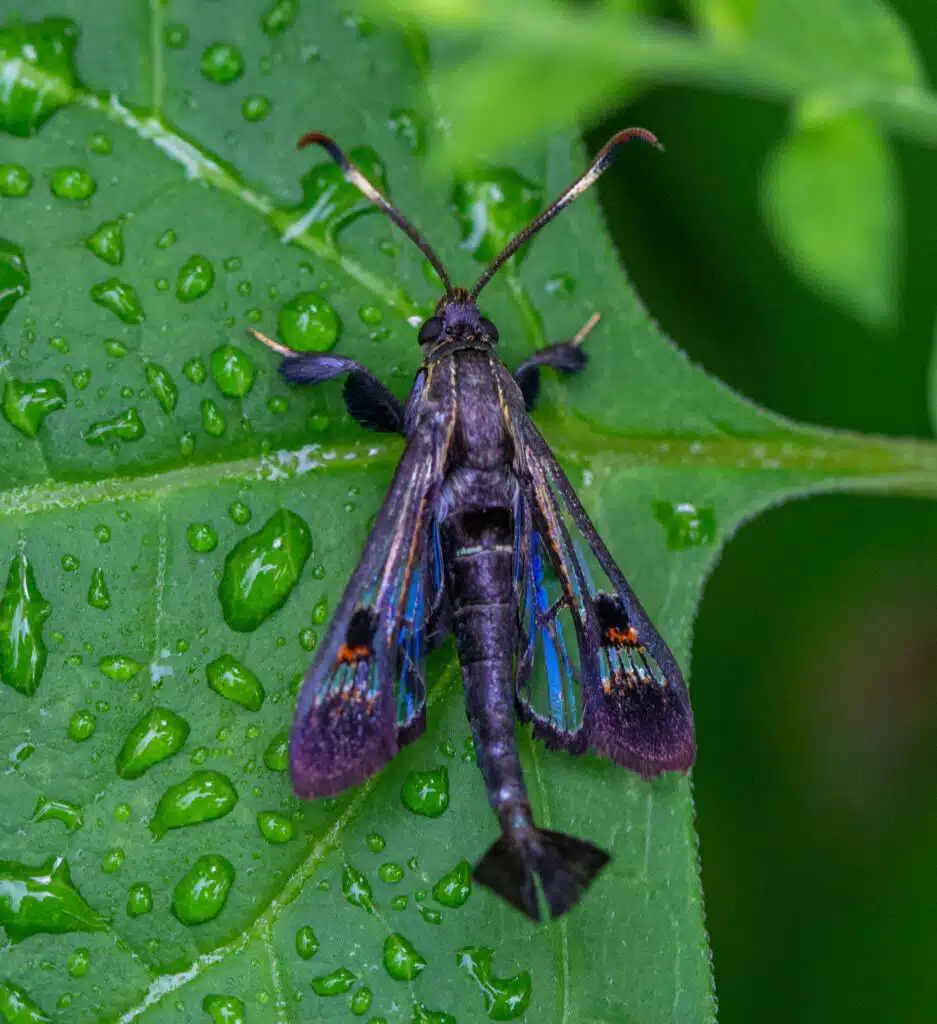
Virginia Creeper Clearwing moths (Albuna fraxini) are a major pest. These moths use Virginia Creepers are a host for their larvae.
The larvae of the species feed on the roots of the tree. Feeding may continue until the tree eventually dies.
The problem with this moth is that it doesn’t only feed on Virginia Creepers. It also feeds on birch, alder, and other types of trees.
In the absence of these trees, Virginia Creeper Clearwing moths also look at alternatives such as fruit trees.
Borer moths of this genus need to be controlled with chemical treatments to avoid major tree damage.
You can identify the Virginia Creeper Clearwing by its black body and transparent wings.
Almost the entire area of the wings is transparent. Only borders and veins are black on the species.
The rest of the body is also mostly black.
11. Scarlet-tipped Wasp Mimic Moth
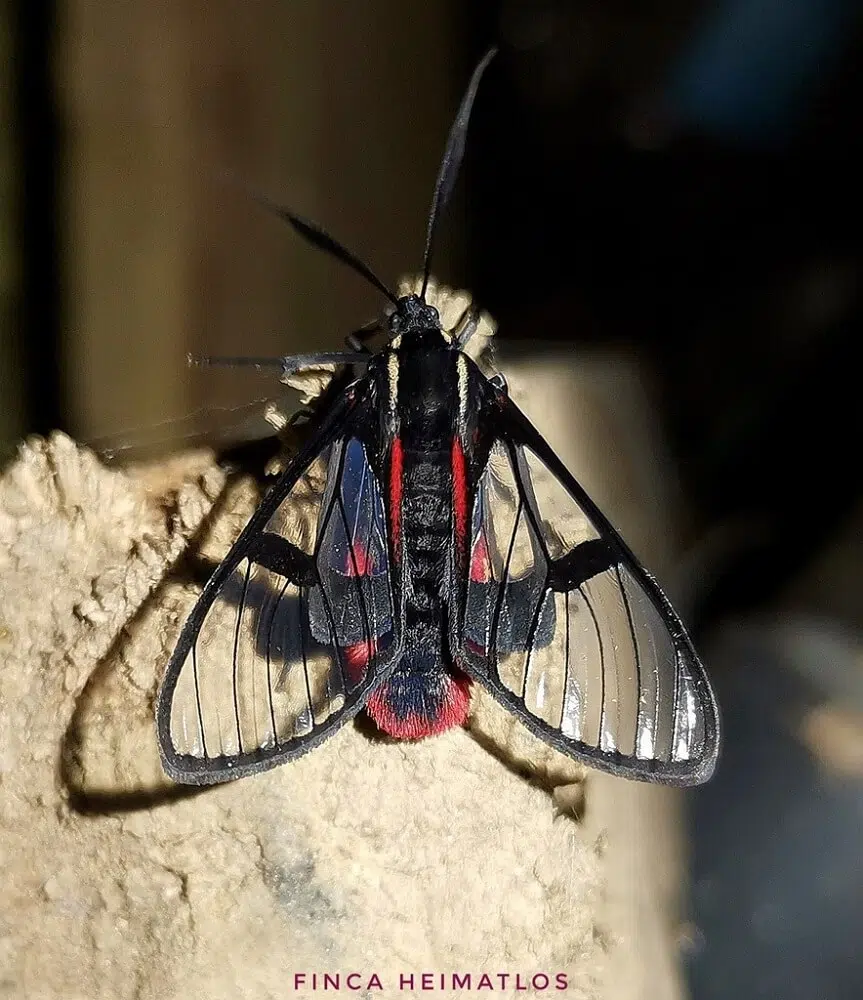
Scarlet-tipped Wasp Mimic Moths (Dinia eagrus) are one of the species with a very large transparent section of the wings.
These moths have glass-like wings with visible black veins or margins. There are no other colored patches across the wings asides from the veins.
The body of this moth has a hairy texture with red and black coloring.
The species mimics a series of red wasps which resemble ants in turn.
Scarlet-tipped Wasp Mimic Moths are also some of the smallest transparent wing moths. They have a maximum wingspan of 1.2 inches
12. Currant Clearwing Moth
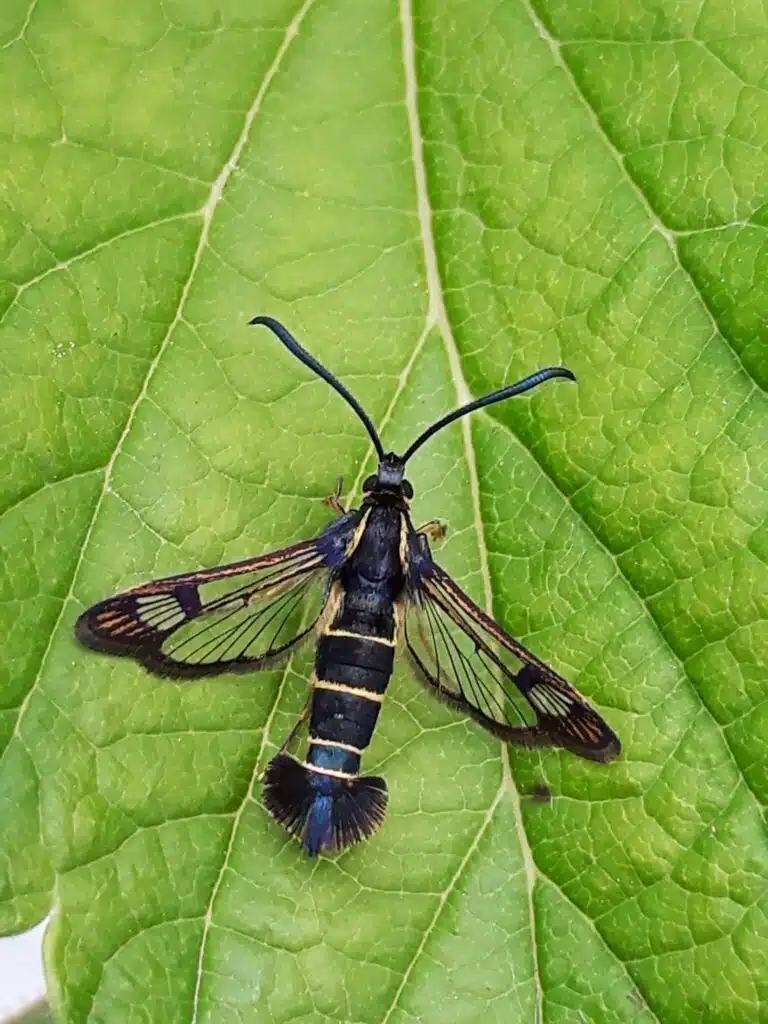
Currant Clearwing Moths (Synanthedon tipuliformis) have a small size. The species grows to a maximum wingspan between 16 and 21mm.
Black and yellow colors are specific to this moth species, just as to other moths that resemble wasps.
A black body with just a few yellow bands is specific to the species. Black hairs are seen at the end of its body.
The wings of the Currant Clearwing Moth are mostly transparent with black borders and black veins.
As its name implies, the moth feeds on currant. It prefers cultivated currants which makes it a major pest.
You can find Currant Clearwings on red currant cultivars. The species is also frequently seen in other areas with currants including urban gardens.
13. Fireweed Clearwing Moth
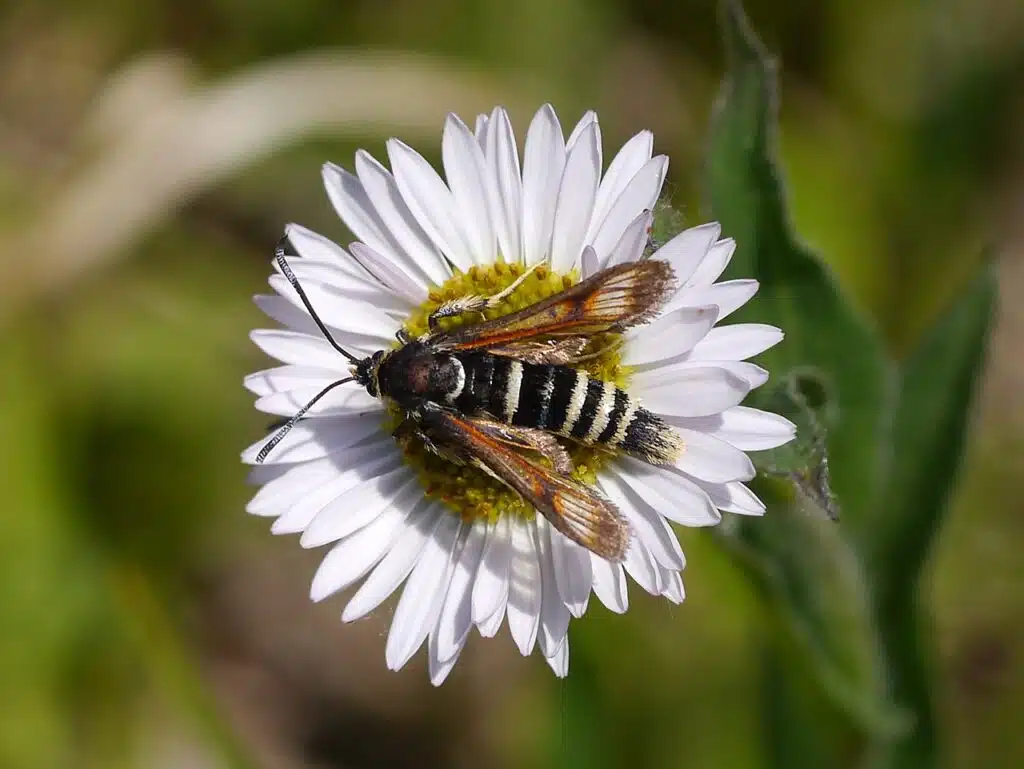
Native to Northwestern US states, Fireweed Clearwing Moths (Albuna pyramidalis) are found in states such as Montana, Idaho, and Wyoming.
This species of moth also mimics wasps. It takes on the shape and colors of typical wasps to avoid predation as it approaches fireweed as well as to safely lay eggs.
Moths of this genus have an elongated body specific to wasps as well as a combination of black and yellow bands across their lower body similar to wasps.
Its upper body is completely black.
The wings of the moth are almost completely transparent. Only the margins and the veins are black.
A narrow brown section is seen across the central section of the wings which differentiates it from other moths.
This species has a long season in its Northern habitats.
Its flight season lasts from May to August.
14. Ironweed Clearwing Moth
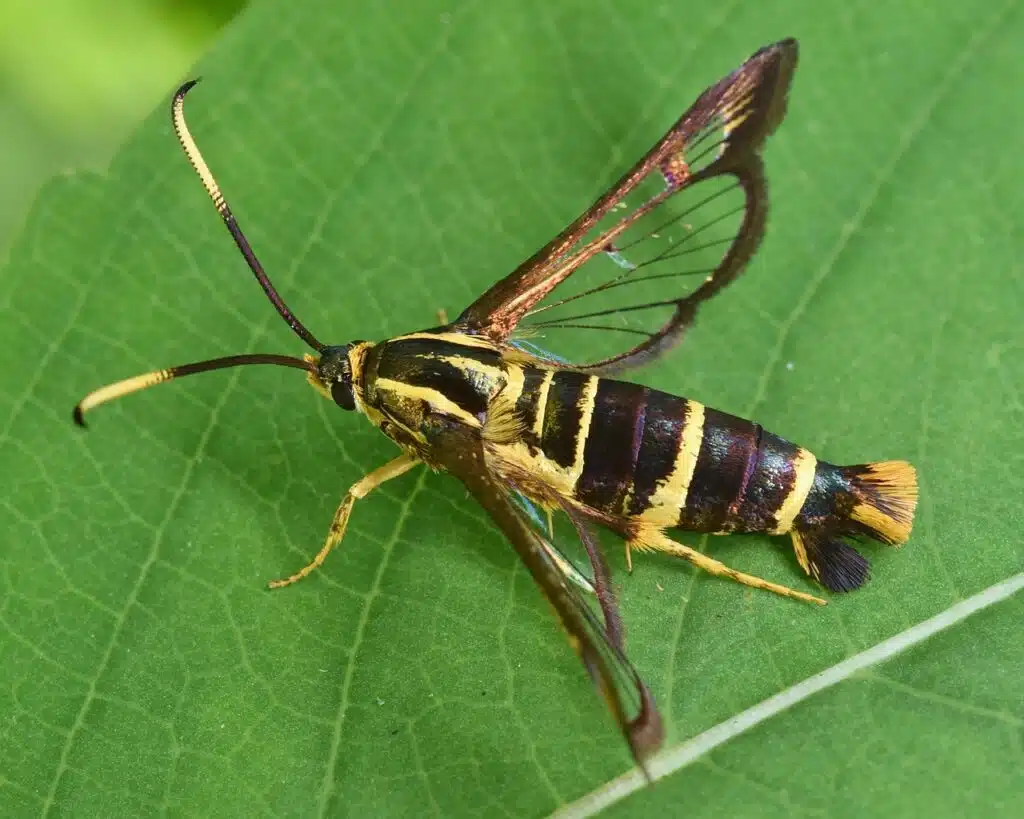
With a long flight season that lasts until September, the Ironweed Clearing Moth (Carmenta bassiformis) is a species that feeds on ironweed.
It’s among the most common species that can completely kill ironweed. This is a type of plant in the family of asters that the moth’s larvae eat.
The larvae of the Ironweed Clearwing Moth feed on the roots of ironweed.
You can identify adult Ironweed Clearwing Moths by their size and color. Its wingspan stretches to a maximum of 26mm.
The moth has an elongated red-brown body with 3 horizontal yellow bands. Lateral yellow bands are also seen along the head of the species.
Its antennae are almost completely transparent except for the red veins and margins.
15. Banyan Tussock Moth
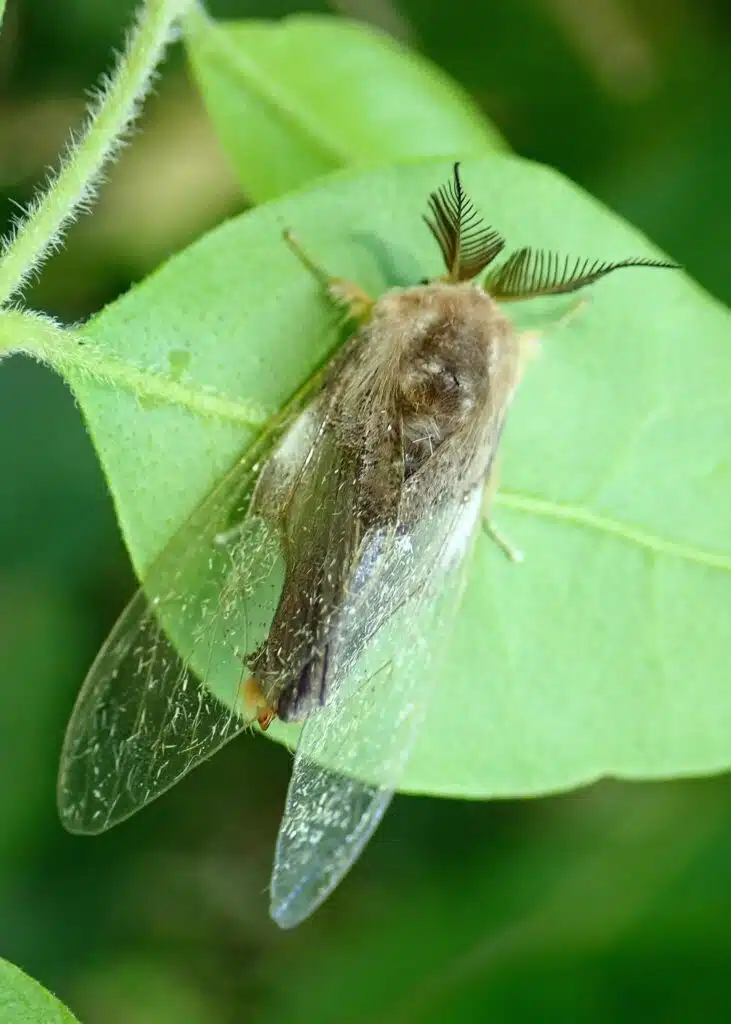
Banyan Tussock Moths (Perina nuda) are partially transparent.
The forewings of the species are almost completely transparent and almost glass-like.
This species has black hindwings. Long black hairs are seen on the lower part of the hindwings.
Its body is also black with a yellow tip on the abdomen.
The antennae of the Banyan Tussock Moth are black with atypical long black hairs.
Common in China and across Asia, the Banyan Tussock Moth is a pest of figs and even mango fruits.
This is one of the few moths with transparent wings humans should stay away from. It carries particles Perina Nuda viruses.
This virus is known for triggering cold symptoms in humans.